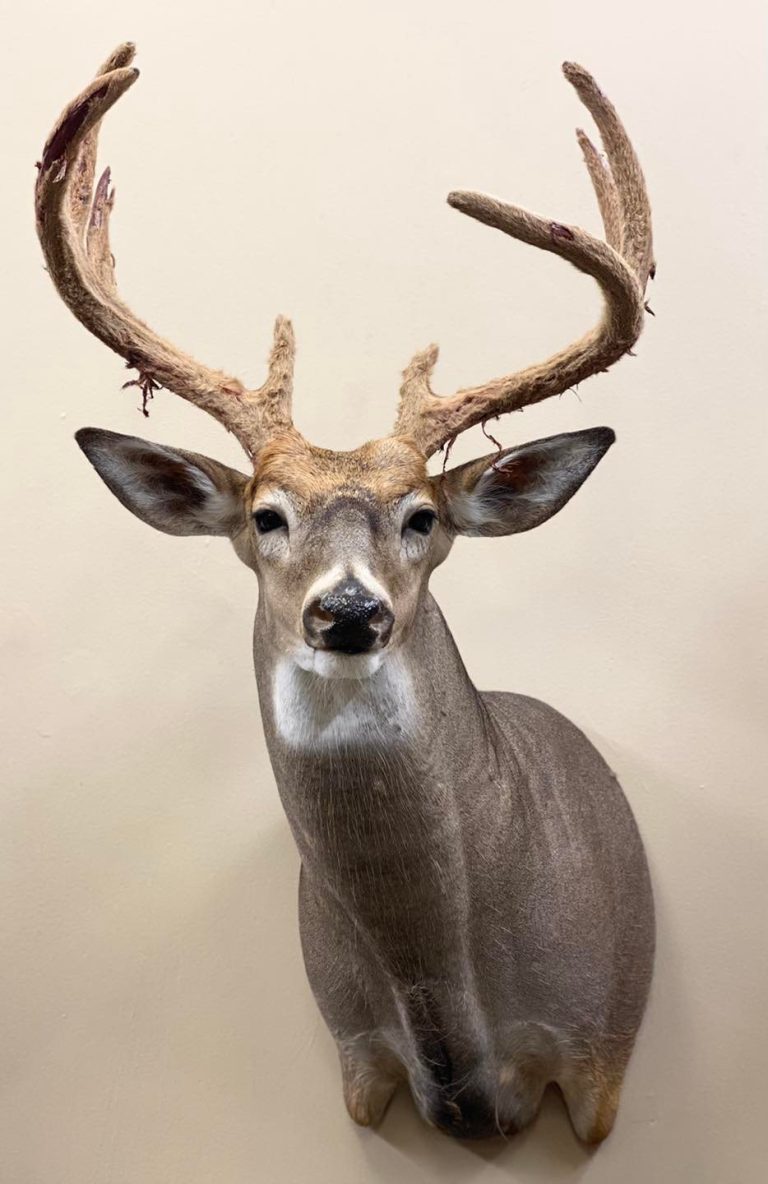Do these steps to help your taxidermist produce a top quality mount
If you have hunted long enough, I’m sure the scenario I am about to describe has happened to you; if not, hopefully, after reading this, you won’t ever find yourself in this position. In my earlier years as a whitetail hunter, I always adhered to the adage if it’s brown, it’s down, especially during gun week. I stuck to this idea because, quite frankly, I was still in the infancy stages of learning to hunt mature whitetail. It was a lot easier to head out to the woods and shoot the first thing I saw. I didn’t have to worry about making the proper cuts when gutting the deer or taking care of the hide as I transported it, the main thing I was concerned with was proper care of the meat till I could get it to the processor. I never thought much about the taxidermist until now.
Sure, I’ve seen some decent bucks during my hunting adventures, but most were out of range for my trusty old Mossberg 500 12-gauge, and the ones close enough for me to take a shot always got the best of me after staring at their antlers long enough for buck fever to set in. That all changed one sunny Friday afternoon. I set out that year hoping to shoot my first decent buck as I felt this was the next step in my hunting career. After passing several deer throughout the week my chance finally came on a nice 140-inch buck. As he crested the hill and turned broadside, I took my shot. After watching him drop in his tracks the excitement set in. The first call was to my wife I told her to get the checkbook ready because I finally had one I wanted to put on the wall. After hanging up the phone, the realization set in that I had no clue what I had to do to get this buck prepared to drop off to the taxidermist. Luckily, I had a good friend who was well-versed in caping out a buck for a shoulder mount. He came over and walked me through the proper cuts and steps to preserve the hide till I could drop him off.
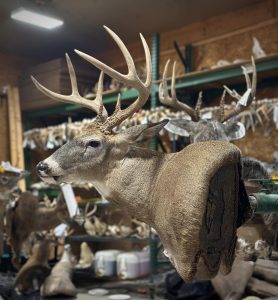
Credit The Back 40 taxidermy
After reminiscing on this experience, I thought it would be a perfect topic to cover. I’m sure I wasn’t the only one in this position. After talking with several taxidermists, I learned there were things that many of us probably never knew that we wish we did to prepare the mounts for them to work. These are award-winning taxidermists, so I listened to everything they had to offer. Hopefully, everyone can learn something from them. I know I did.
How to Handle a Buck in Velvet – The Back 40 Taxidermy in Gladwin, Michigan
Here is what Tyler from The Back 40 Taxidermy had to say: I feel like one of the biggest things I wish people considered is the time of year and conditions of the hunt. By this, I mean if it is early season and 70 degrees, it’s pertinent to get your deer into them as quickly as possible, especially if it’s in velvet. A whole rack of velvet can fall apart in a matter of a couple of hours. The conditions also play a big part; if it’s raining or wet, it naturally breeds more bacteria, and this can deteriorate the hide faster. Even if it’s cold outside, we don’t suggest waiting for more than 3 days. Many different factors can happen from not taking proper care of your hide. One thing is hide slipping. Another is that sometimes bacteria breed and you won’t notice it until the tanning stage. The fact of the matter is that the sooner it gets to a taxidermist, the better quality and nicer looking mount you will end up with. Be sure you have the time allotted to take care of your trophy, so it doesn’t turn bad on you. Another point is field care, when gutting, skinning, and dragging. Keep all cuts behind the front shoulders when caping a buck and you’ll be safe. When dragging your deer, be sure to keep the front shoulder off the ground as well, or you could end up with some unwanted drag marks on the hide. When it comes to capeing a buck, I’m not saying processors do a bad job, but it’s better to have your taxidermist cape your buck. Pretty much all reputable taxidermists would rather skin your trophy for you. This ensures both parties involved know all is well and there are no issues. If there is they should be brought to your attention at that time before any taxidermy project is started. I feel it is important to know what to do between the time you shoot your deer and the trip to the taxidermist.
Field Dressing Your Buck – Josh Saville Taxidermy in New York
When talking with Josh Saville, he had some great tips to keep in mind. His absolute number one tip would be field dressing. Knowing how to cape a deer is essential to getting a nice, clean mount back. I always urge guys to check with their taxidermist first to see what kind of incision they would like, and the necessary steps to preserve the hide. Some prefer them frozen, and others would prefer them salted. Cape handling and care after the shot is also a huge plus. If you are going to drag the deer, make sure that it is elevated or on a cart of some sort. Dragging deer across dirt and rocks will result in hide damage. Everybody likes to take photos to remember the hunt so in doing so be cautious that you are not damaging the hide in the process.
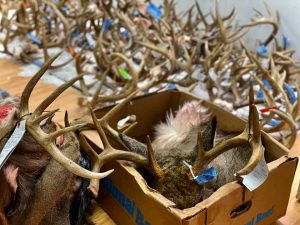
Photo Credit The back 40 taxidermy
Another great tip is that many hunters do not consider is to Include your taxidermist in your hunting plans. Josh said he sees a trend of Taxidermy shops filling up and closing their books. A well thought out trip and an agreement with a taxidermist ahead of time will always help to ensure you can preserve your trophy. That way you are not scrambling to find somebody last minute.

Credit The Back 40 taxidermy
Shot placement is always controversial. However, if you can wait for a shot that will not affect the mount, it is always better to do so. A lot of times, I hear guys talk about taking a neck shot because it is all they have a chance at. It is good to remember that if you take a neck shot, it will need to be repaired most likely, and the damage can vary from a very small hole to a very large gaping wound, which is harder to fix of course.
Turkey Mount tips – Timberview Taxidermy in La Harpe Illinois
Here are Tanner’s thoughts. When it comes to turkey hunting out of state or just in general, I like to wrap the head in a paper towel and put a zip lock bag over it. I then tape it to keep the blood off the feathers before going to the taxidermist. Another thing I often see is a lot of guys taking deer to lockers and just dropping them off to have them capped and processed later. Then they take it to the taxidermist. This is not good! After a turkey, deer, or any animal is harvested, you have 24 hours if temperatures are over 40 and about 48 hours if below 40 degrees to get the hide off the meat and back in the freezer. After that, bacteria start growing in the hair follicles. This is called hide slipping. The last 2 years, I’ve seen multiple capes ruined by lying at the processor for too long. These are two big things I see often and that I tell my customers all the time!
General Deer Tips for creating an exceptional mount
The number one piece of advice most taxidermists offered when it came to getting the best mount back was proper caping of the buck. Most people, when capeing out their buck, don’t leave enough hide for a proper shoulder mount. It’s best to leave as much hide on the buck as you can. They can always dispose of the excess hide, but they cannot replace what’s not there. It is best to have an experienced person show you the proper way to cape out your first buck. When it comes to field dressing, it’s important to do this right away and cool your animal down. Time is not your friend, as bacteria almost immediately start to form. This accelerates with heat. Not only can this damage your hide it can also damage your meat. When field dressing your buck, it is best to stop your cut at the sternum and reach as high into the chest cavity as possible to keep the hide in one piece.
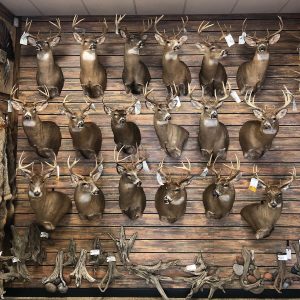
Photo credit Nabers taxidermy
If you’re unable to drop your cape off right away, it’s best to lightly roll the hide up, being careful not to crease or damage it, and place it in garbage bags in the freezer. This will preserve the hide till you can drop it off. Never let the cape encounter water or ice as this can damage it. The last big tip offered was that if you are planning to shoot a buck in velvet, you must take extra special care so as not to damage the velvet. The best way to do this, according to Nabers Taxidermy in Grand Rapids, Michigan, is to use a product called Velvalok from Velvet Antler Technologies. It’s easy to use and ensures your velvet stays intact.
General Turkey Tips for creating an exceptional mount
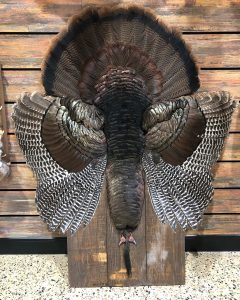
Credit Nabers Taxidermy
Not only does turkey meat taste great, but they also make some awesome mounts. These are a few things many taxidermists wish you knew before pulling that trigger to get the best mount possible. The first thing to consider is shot placement. If using a shotgun, proper pattern placement is vital. When shooting a turkey, it’s best to aim for the head. Most taxidermists will use a replica head unless your head is in good enough shape to freeze-dry. This kind of shot helps prevent damage to any of the feathers, especially if the tom is in full strut. They recommend not to shoot a tom in full strut, so you don’t risk damage to any of the tail feathers.
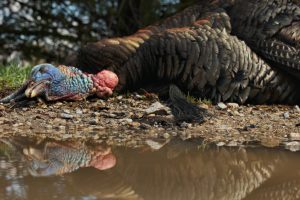
Photo credit Timberview Taxidermy
Another consideration is the storage of your harvested tomato. You want to cool your trophy down as soon as possible, and always handle it carefully. Pay careful attention to ensure that you don’t damage the feathers. When carrying him from the field, it is best to hold your tom by his legs, letting his body drape over your back. This prevents him from getting blood all over his feathers as well, ensuring you’re not dragging his feathers on the ground. The last thing to keep in mind is that it’s best to get to the taxidermist right away. If you have never skinned out a turkey, it’s best to let your taxidermist do this and remove the breast for you. If that is not an option, it’s best to call your taxidermist and see how he wants you to preserve your turkey until you can deliver it to him. It’s always best to work with them ahead of time if possible as it makes everybody’s job easier and allows you to get the best mount possible. Good Luck!
How to Cape a Buck for a Shoulder Mount
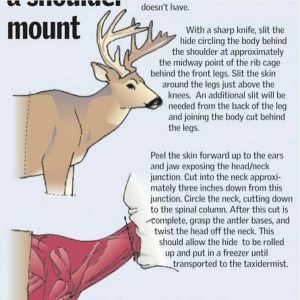
Photo Credit Timberview taxidermy
Read also: Larry Weishuhn’s Guide to Choosing a Taxidermist
Per our affiliate disclosure, we may earn revenue from the products available on this page. To learn more about how we test gear, click here.



